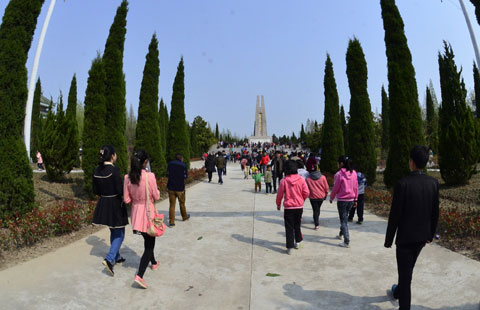Rare duplicate of Chinese classic opens to public
Updated: 2014-04-19 15:47
(Xinhua)
|
|||||||||||
A rare duplicate of a classic Chinese book opened to the public in East China's Jiangsu province on Friday.
The reproduction of the "Siku Quanshu," or the "Complete Library in the Four Branches of Literature," is available to view free of charge in the Wanfo Building at Tianning Temple in the city of Yangzhou, said Wang Genbao, chairman of the copy's maker, Yangzhou Bindings.
The "Siku Quanshu" originally had seven copies, most of which were destroyed during warfare. The Yangzhou copy, which took more than a decade to make, was based on the classic's "Wen Jin Ge" edition, one of three remaining completely preserved copies. The original "Wen Jin Ge" edition is currently preserved at the National Library of China (NLC).
The company's general manager Lu Guobin said the company has created a digital version of the classic for the first time in history, which will help preserve and spread the masterpiece for later generations.
The copy, which contains Chinese philosophy, history, classics and literature, is published by the Commercial Press. It has the same size, color and print as the original copy in the NLC.
Compilation of the "Siku Quanshu" launched under the reign of Emperor Qianlong (1736-1795) in the Qing Dynasty (1644-1911). Organized by the literary emperor himself, more than 360 scholars and 3,800 scribes joined in the compilation, with a total of 800 million characters, said Wang, also a researcher with the collection.
By covering a wide range of knowledge and organizing most of the significant works from various schools of Chinese thought, the imperial collection is one of the biggest volumes ever compiled in China.
Related Stories
Books, not loving looks; schools ban puppy love 2013-12-24 10:14
Chef Ferran Adria shows up during the Catalan book week 2013-09-24 11:21
Shanghai Metro offers passengers books to borrow 2013-08-27 10:29
Book fair attracts more digital and foreign publishers 2013-08-27 09:17
Today's Top News
Ukraine govt mulls constitutional reform
APEC fuels interest in English
Anti-graft push gives more family time
Property price surge could soon over
Three dead in Ukraine, Putin warns of 'abyss'
Ferry's captain under probe
Nobel laureate Marquez dies at 87
Quality of arable land 'worrying'
Hot Topics
Lunar probe , China growth forecasts, Emission rules get tougher, China seen through 'colored lens', International board,
Editor's Picks

|

|

|

|

|

|






